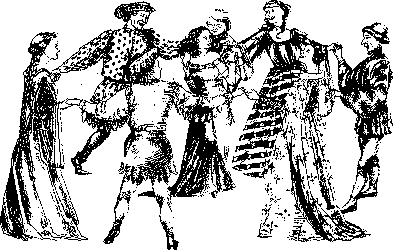Music in Medieval Jewish Spain
Updated October 27, 1998
Musical instruments in medieval Spain include the lute, the hurdy-gurdy, the Muslim oval guitar, the Latin guitar, the Muslim rebec, the viol, "a tiny 2-string fiddle", psaltery, bells, flutes, trumpets, horns, harps, bagpipes, castanets, and the pipe and drum (From Spain: The Root and The Flower by John Crow, 1985). See this page for a description of the lute, and how it derived from the Moorish ud.
Many Ladino folksongs have been preserved through the Sephardic tradition after the expulsion. Most have been passed down orally from mother to daughter, who may have continued to speak in Ladino while the men, who worked outside the home, learned the local language of their non-Jewish countrymen. It is thus hard to tell which ones can actually be traced to Spain. However, the same songs can be found in the Sephardic communities of Morocco, Greece, Turkey, Bosnia, Bulgaria and Israel, which implies that the songs are from before 1492. Many of these songs were sung unaccompanied.
Alfonso X, the Wise, is known for his cantigas (songs) devoted to the Virgin Mary. They were written by the king or under his direction. Curtis Clark has some recordings of the Cantigas de Santa María on his website, the Internet Renaissance Band. See the section on Medieval Music (Anonymous).
A list of Sephardic music disks is found here.
Judith Cohen is an ethnologist and musician who specializes in Sephardic music.
Florata's Home Page The page for "Ensemble Florata" a British music group performing the traditional music of the Sephardic Jews and other medieval music. Their albums include Magnificentia Iberica and Far Away Land.
Judy Frankel's Home Page, a San Francisco-based singer whose Sephardic music albums include Scalerica De Oro, Silver and Gold, and Sephardic Songs of Love and Hope
Sylvain's Ladino Melodies - A collection of Ladino songs in Real Audio (warning - this page takes a long time to load!).
Ladinostalgia, a Jerusalem-based group which sings a variety of Jewish ethnic songs, including Sephardic Ladino music.
Dance: Martial, a writer from Imperial Rome, described the gaditanas or dancing girls of Cádiz in the 3rd Century. He said they dance with crusmata or castanets, and describes their "gracefully raised arms, the swirling figure, the sinuous movement, the dark emotions". (From Spain: The Root and The Flower by John Crow, 1985).
This page is part of Chaiya's Sephardic World, a website devoted to the history and culture of Jews in Medieval Spain. The site is centered around the fictional SCA persona of Chaiya bat Avraham Toledano, created by Stacy Braslau-Schneck, the author of these pages. Chaiya is a Jewish lady living in Toledo in the 1230s. The SCA, or Society for Creative Anachronism, is an educational organization devoted to researching and recreating the Middle Ages.
I do not claim to be an historian, only a hobbyist. All errors are mine, all text is copyrighted to me, and all comments are welcome! "Yad/Return" image ©2001 Ilene Winn-Lederer
![]() Return to Chaiya's Sephardic World
Return to Chaiya's Sephardic World
Continue on to La Convivencia, the time of peace between Jews, Muslims, and Christians.